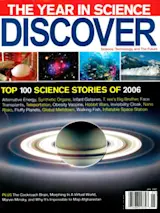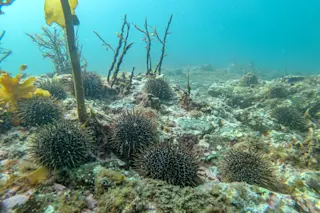1.Alternative Energy
The unnervingly high price of oil — along with the increasingly intensive drilling to get it — has suddenly pushed renewable power squarely into the mainstream
In September Chevron announced the discovery of a field containing up to 15 billion barrels of oil beneath the Gulf of Mexico, touting it as "a platform for growth for years to come." Read the fine print, though, and you get a different story. To recover the first samples of oil there in 2004, engineers floating 175 miles off the Louisiana coast had to send drill gear into 7,000-foot-deep water and penetrate four miles of rock. The company spent tens of millions of dollars on computer modeling, cutting-edge seismological tools, and exploratory drilling; just renting the drill rig cost Chevron and its partners more than $200,000 a day. The results suggest that oil from the new reservoir, called Jack 2, could cost three to four times as much to extract as oil from traditional locations, including rigs on land.
You don't need to look as far off as Jack 2 for signs that the end of cheap oil is nigh. In 2006 oil prices hit a record high, $77 a barrel in the summer. Analysts blamed the price hikes on damage from the 2005 hurricanes, continued turmoil in the Middle East, and jitters over tightening supplies from Venezuela to Iran. Prices have eased since then, but the relief is probably temporary: Oil consumption is growing rapidly in China and India as their middle classes awaken to the taste for consumer spending that Americans have long enjoyed. These two oil-poor economic giants are buying up oil interests in places like Nigeria; early this year China spent $2.7 billion for an offshore field there.
The upside of stratospheric oil prices is reflected in what is happening on the other side of the balance sheet. The past year looks like the turning point when alternatives to fossil fuels — everything from solar energy, wind turbines, ethanol, and the hybrid car — finally hit the mainstream. "We'll look back and say this is the year where people rallied together to start down the irreversible path of becoming less dependent on oil," says Samir Kaul, a partner in venture capital firm Khosla Ventures in Menlo Park, California, which invests in energy and other tech startups.
Hamilton and Kaul are cheerleaders for the renewable energy industry, but even hardened policy types see the need for new sources of energy. Security hawks have stepped up their rhetoric during this election year to push for more hybrid cars and biofuels, and for billions in new research to reduce the country's dangerous dependence on foreign petroleum. "We are fighting a war against terror and paying for both sides of the war," says James Woolsey, a member of the Set America Free Coalition.
Meanwhile, the markets are voting with their dollars. By the summer, the stock market value of all renewable energy firms larger than $40 million doubled, to total $50 billion. Venture capitalists, big banks, and even old-school bond peddlers jumped in. This past year, 39 French and German wind farms bought nearly $600 million in bonds in May from Italian Bank UniCredit's HVB Group — a deal that would have been unheard of even two years ago, says Eric Martinot of the Worldwatch Institute. "For a long time renewables were seen as almost an eccentric source of energy," says energy industry reporter Caroline Gentry of Argus Media Group. "That's changing."
Around the globe, policy makers too, have been seeking greener sources of energy. In 2005 China tied with Germany for the most new investment in renewable energy, pouring $7 billion into millions of rooftop solar heating units, small hydropower stations, and photovoltaics. According to Martinot, the onslaught continued in 2006 as China stalked its goal of doubling the fraction of its energy that comes from renewables to 16 percent by 2020. "They'll reach that goal and probably surpass it," he says. The Bush administration's goals in this area include powering 2 million homes by 2015 with solar energy and obtaining three-quarters of the country's automobile fuel from ethanol and other non-Middle Eastern sources by 2025.
Excluding hydropower, renewables make up only 3 percent of U.S. energy sources, but the sector was easily the fastest growing in 2006. Leading the way was ethanol. In 2005 Congress mandated that 7.5 billion gallons of it be blended into America's gasoline by 2012, and a total of 48 new ethanol plants in the United States are under construction. China, too, has developed a taste for biofuel, with officials in nine provinces requiring that automobile fuel contain 10 percent ethanol.
Across the United States and Europe, wind farms sprouted up like weeds. By the summer of 2006, the amount of energy produced by windmills in the United States exceeded 10,000 megawatts (enough to power 2.5 million homes), as windmill developers from Texas to Minnesota gobbled up tax credits. Worldwide, 2006 wind spending was expected to top $15 billion, with the United States, Germany, and Spain in the lead. "Everybody's going as fast as they can," says Martinot. Businesses like steady costs, and Christian Kjaer of the European Wind Energy Association points to the predictability of a windmill's energy output over many years as "a hedge against the uncertainty of fuel prices."
In Colorado more than 1,000 people sat on a waiting list for a program offering wind power to utility customers. The first requests were from individuals committed to green power, says a spokesperson for the local utility, Xcel Energy. But in November and December 2005, wind power in Colorado cost less than electricity from fossil fuel, and the average household that switched to wind saved $4 a month on its electric bill. "The interest in renewables is here to stay," says Jim Owen, a spokesperson with Edison Electric Institute, an electric utility trade association in Washington, D.C.
Another stalwart renewable source — solar power — is finally gaining traction as prices of solar panels and water heaters have decreased and environmental concerns have grown. In 2006 California installed enough new photovoltaic capacity to power roughly 20,000 homes. The sun craze has spread nationwide too. For decades, 56-year-old builder Daryl Bergquist of Royal, Alabama, installed the occasional solar panel as a side job. Now he is consulting with green-minded homeowners and supervising solar installation crews full time. "The past year and a half has been the first where this is my main source of income," he says. Driving demand, he says, are high energy costs and individuals "realizing that global warming is real."
While a federal tax incentive expiring in 2007 has helped spur wind and solar energy, local players have shown their own interest in establishing renewable energy sources. Twenty states have set targets for how much of their energy should come from renewable sources, with many as aggressive as the European Union's target of 12 percent of energy consumption from renewables by 2010. In California, governor Arnold Schwarzenegger aims to put solar panels on a million roofs. Although California voters rejected in November a proposition that would have raised funds for alternative energy research with a tax on fuel, Washington State voters passed a renewable requirement for their utilities, joining Colorado as the second state whose citizens directly voted for green energy.
Even Big Oil is jumping headlong into the renewables market. British Petroleum, for instance, is spending more than a billion dollars to fund hydrogen power plants in California, as well as projects in wind and solar power. Other investors include Shell and Chevron. The latter cut a five-year deal with the Department of Energy's National Renewable Energy Laboratory in Golden, Colorado, to develop fuels from farm waste, excess from feed crops, or biomass from shrubs.
With the new investments comes expanded funding for research, and scientists are vigorously going about solving the problems that keep alternative energy sources, well, alternative. While not-in-my-neighborhood objections are one obstacle to wind power (as exemplified by this year's fuss over proposed wind turbines off Cape Cod), there are also engineering problems to confront. Wind turbines usually sit on platforms bolted to the seafloor in shallow coastal waters, so they miss steady wind currents that blow further out at sea. This year mechanical engineer Paul Sclavounos of MIT introduced an answer: an offshore windmill design that sits on floaters like some oil rigs do. The design, which he claims is hurricane resistant and easily transported, could allow turbines to tap winds 90 miles offshore without requiring expensive towers.
Chemists are also working on improving the efficiency of fuel cells — devices that use replenishable, stable chemical reactions to produce electricity — so that cars can run on hydrogen produced by renewable, non-carbon-emitting power sources. In one small breakthrough, researchers at the University of North Carolina at Chapel Hill have created new fluoropolymers that conduct protons three times better than current fuel cell coatings. Robert Hockaday, who founded Energy Related Devices, a company working on fuel cells in Los Alamos, New Mexico, told Science magazine that the material "could set a new gold standard."
To be sure, many alternative energy buffs remain skeptical of the long-touted hydrogen economy, which would presumably require a huge (and politically problematic) investment in new infrastructure. But tell that to BMW and GM. In September both companies announced plans for hydrogen-capable cars. The hydrogen would be derived from fossil fuels while researchers explore other methods of production. GM's fuel cell SUV, Sequel, operates with an energy efficiency equivalent to 39 miles per gallon of gasoline.
Even the electric car, largely given up for dead, made a comeback this past year. At MIT researchers are working to replace conventional batteries with ultracapacitors, which can be recharged far more quickly and last more than 10 years (see story #92, "Capacitors Could Replace Batteries"). Ultracapacitors, like fuel cells, can take in the unsteady flow of energy from wind turbines or photovoltaic cells and store it so that it is available exactly when needed. Plug-in hybrid cars, says Martinot, might also be part of the solution. They could store a charge from wind energy at night and absorb sunlight hitting their rooftop solar cells if parked during the day. In the meantime, Tesla Motors in Silicon Valley is wowing the well-heeled with a conventional electric car powered by unconventional lithium batteries that can blast this $100,000 Lotus-based roadster from 0 to 60 miles per hour in four seconds.
And the energy technologies themselves are improving. Nanosolar, in Palo Alto, California, which announced plans to build the world's largest solar-panel plant, is using nanotechnology to devise solar cells that can be printed like newspapers. Because these cells can be made more quickly than bulky solar panels, the company thinks they might be cost-competitive with coal or nuclear power. Chemists at the National Renewable Energy Laboratory are closing in on cheap ways to make cellulosic ethanol, a form of ethanol derived from agricultural waste rather than food crops like soybeans or corn. Wind-power engineers are developing new turbines that are far more efficient than those built just a decade ago.
"The question about renewables is, Will it be like fuel cells a few years ago, or fiber optics? That had a lot of venture capital in it but few quick returns, and so investors went off and did other things," cautions Nate Lewis, a materials chemist at Caltech who works on solar cells. Keeping the field moving, he suggests, will require funding more basic research. The total federal spending on basic energy research and development doesn't even match the funding at one big institute within the National Institutes of Health. Although many legislators on Capitol Hill see the need, the committees that set the federal budget have yet to tackle the issue aggressively.
Pramodh Panchanadam, an energy analyst at the Frost & Sullivan office in Toronto, thinks all the current renewable energy sources are merely stopgaps until we hit on the true successor to oil. "This is just a balancing time before we get to a disruptive technology," he says. Meanwhile, scientists are working feverishly to achieve that breakthrough—in biomass, superefficient solar cells, or perhaps nuclear fusion. If they succeed, the next Jack 2 could come not from a drill hole four miles below the ocean floor but from a test tube or a packet of plasma.
Eli Kintisch
21.World's Largest Marine Preserve Created
In June President George W. Bush designated the Northwestern Hawaiian Islands as a national monument, establishing the world's largest sweep of fully protected ocean. The Northwestern Hawaiian Islands National Monument spans 140,000 square miles of ocean, island, and reef. Bigger than the Great Barrier Reef Marine Park and larger than all U.S. national parks combined, the region harbors more than 7,000 species, including critically endangered Hawaiian monk seals. The national monument designation eventually will ban all commercial and recreational fishing within its borders.
"It's the best underwater piece of real estate in this country," says Marine Conservation Biology Institute president Elliott Norse. "With this one act, the United States put in a bid to become a world leader once again in marine conservation."
Megan Mansell Williams

Courtesy of Jill Greenberg
Jill Greenberg
26.Orangutans Face Genetic Doom
The future of the orangutan — already endangered — dimmed further with the release of a genetic study charting a steep population decline.
Conservation geneticist Benoît Goossens of Cardiff University in Wales and his colleagues gathered DNA from the feces and hair of 200 orangutans in the Kinabatangan Wildlife Sanctuary in Borneo. By examining bits of DNA called microsatellites, which mutate rapidly, Goossens was able to trace individual genetic differences back to a common ancestor and estimate the size of the orangutan population at different times in the past. The data reveal that the animals' numbers have plunged 95 percent over the past two centuries, coinciding with the arrival of settlers and the rapid clearing of forest habitats.
If the population continues to drop at current rates, the orang may be extinct in a few decades. Fatal inbreeding might occur even sooner, Goossens says: "If nothing is done in the near future, this could start in less than 25 years."
Kathy A. Svitil
30.Engineered Cotton An Environmental Bust
Seven years after China's farmers began planting genetically engineered cotton — tailored specifically to resist bollworm infestation without chemical sprays — they are using just as much pesticide as they did before, researchers reported in July.
Genetically modified "Bt cotton" carries a bacterial protein that is toxic to the bollworm, the main cotton pest. In theory, that should significantly reduce the need for pesticide. But when Shenghui Wang, an economics doctoral student at Cornell University, interviewed farmers in China, she found the ones growing Bt cotton spending as much on pesticides as those who hadn't made the change.
The reason: Bt cotton was so successful initially that farmers cut back on pesticides; secondary pest populations then boomed, requiring renewed spraying. Wang's findings suggest that getting the full value from genetically modified crops may require more knowledge about how the system works — and better education for the farmers who use it.
Rabiya S. Tuma
62.Biodiversity Aids Productivity
The results of a decade-long experiment, published in June, indicate that biological diversity helps make ecosystems stable and productive. In the study, conducted in the Cedar Creek Natural History Area in Minnesota, researchers seeded large plots with one or a group of 2, 4, 8, or 16 plants chosen from 18 perennial grassland species. Over 10 years the scientists measured the amount of new growth (productivity) generated by all species in each plot, and the variability of that productivity (stability) from year to year.
Areas with more diverse kinds of plants were both more productive and more stable. "Plots with many species are much less prone to big dives in productivity from year to year," says Peter Reich, a coauthor of the study and a professor of ecology at the University of Minnesota. That is another reason for concern about the worldwide decline in biodiversity, he notes: "The loss of diversity is probably having adverse effects on stability and productivity and the ability of the ecosystem to respond to global climate change."
Nicholas Bakalar
69.Weed's Weapon Revealed
Garlic mustard's weapon is a chemical that kills soil fungi...Garlic mustard, a European weed introduced to the United States in 1868, is advancing rapidly through mature forests, crowding out local plants as it goes. In May John Klironomos, of the University of Guelph in Ontario, and his colleagues revealed what makes the plant so tenacious in its new setting.
Garlic mustard's weapon, Klironomos finds, is a chemical that kills the soil fungi that help many plants, including woody trees, obtain key nutrients. "Attacking the friend of your enemy can be just as effective as attacking your enemies themselves," Klironomos says. The chemical, which hasn't yet been identified, lingers in the soil for years, preventing competing seedlings from setting root.
Klironomos is now comparing the North American strains of the weed with native ones in Europe to determine why garlic mustard began aggressively expanding its range only in recent years. That information may explain why other nonnative species become invasive and may suggest new ways to tame them.
Rabiya S. Tuma















